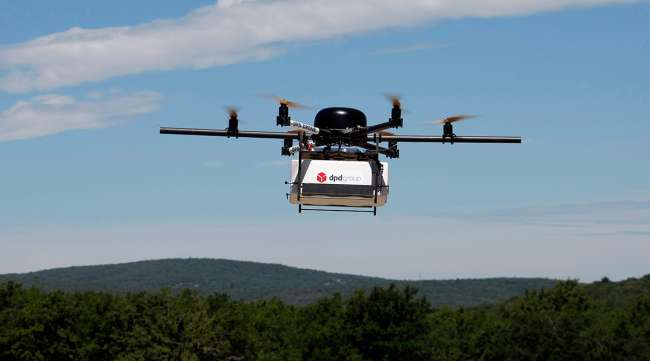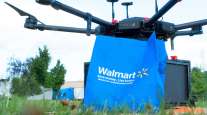Fifty-Mile Drone Flights Beckon as Industry Pushes FAA on Rules

Retailers, railroads and electricity companies are pressing for U.S. government approval to fly drones longer distances. Regulators, geared to an aviation industry that can take five years to get a new jetliner in the air, are struggling to adjust to the breakneck pace.
The companies see an opportunity to vastly increase the usefulness of unmanned aircraft as industrial scouts and aerial delivery robots, surveying power lines after a storm or dropping your latest online order at your doorstep. They’re pushing the Federal Aviation Administration to loosen regulations that restrict drones to short daytime flights below 400 feet.
“You need to be able to fly farther to really make a difference,” said Michael Chasen, CEO of PrecisionHawk, a company that collects data by drone. “When you get to 20 to 50 miles, that’s when you can start replacing the helicopters and planes at lower cost and higher quality.”
The coming of the drone age is putting would-be operators at odds with FAA, which fears that broadening the market for commercial use could lead to more interference with passenger jets, private planes, freight carriers, helicopters, crop dusters and even recreational fliers that make U.S skies the most crowded in the world. Regulators have been reluctant to let drones operate beyond a human pilot’s line of sight.
Crowded Skies
Safety officials face the daunting prospect of tracking and directing hundreds of thousands of drones crisscrossing urban skyways. Companies are convinced they’ve got the technology and experience to make it work — and warn that if the United States doesn’t move faster, it risks falling behind other countries that are expanding commercial drone use.
Reports based on three years of testing that FAA coordinated with private companies bring a fresh batch of evidence that the United States is ready to unleash its drones. Members of the Senate will hear some of the findings May 8 at a hearing to consider how best to integrate drones into the national air network.
FAA says it already has rules in place to approve long-distance drone flights for applicants that can prove their operations are safe. Xcel Energy Inc. just received permission to fly drones to monitor miles of power lines, and BNSF Railway Co. has been allowed to make flights as long as eight hours to inspect railroad tracks for damage.
“We firmly believe our regulatory structure today allows you to do these operations,’’ said Earl Lawrence, FAA’s chief of unmanned aircraft integration. “We just need you to come in and show us how you’re going to meet the safety requirements.”
But FAA has granted only about 1% of the 1,200 applications to fly beyond the line of sight, according to PrecisionHawk.
‘Immense Pressure’
The process to gain approval is costly and tedious, said Todd Graetz, chief of BNSF’s drone program. Sensors and controls needed to avoid crashes, such as light-weight radar, need to be custom-built at great expense. Those costs won’t come down until more long-distance flying expands the market for manufacturers to get economies of scale, he said.
“There are people who want to do some pretty innovative things with medium- to long-range flying, whether it be inspection or deliveries,” Graetz said. “So, there’s immense pressure on the FAA.”
Zipline, a company using drones in Rwanda to drop off medical supplies in remote areas, has made more than 5,000 long-distance drone flights traveling more than 186,000 miles over the African nation. Hoping to apply its business model in the United States, Zipline has yet to hear from FAA on its applications, said Keenan Wyrobek, a founder of the company.
“None of that’s come out on the other side,” Wyrobek said of the process.
Pathfinder Study
FAA has little independent performance data on the plethora of new drone models and sensors, which makes it difficult to develop safety standards for the equipment. BNSF is one of a few companies that participated in FAA’s program, called Pathfinder, to fly drones for miles at a time.
Results from a three-year study of those flights, released last week at a drone conference in Denver, show that the technology works and operations are safe, Chasen said. The Pathfinder reports are being used to push FAA to develop a program for certifying more drones for long-distance commercial flight. The findings provide “a blueprint for putting together the safety case for flying 50 miles out,’’ he said.
The government, meanwhile, won’t compromise safety for speed, said Steven Bradbury, general counsel for the United States Transportation Department. Already, 150,000 commercial drones are registered with 70,000 drone pilots certified by FAA, and as the numbers rise, more near misses and a few crashes with other aircraft have been reported.
Third-Party Auditors
Regulators also need to consider privacy concerns, local and state restrictions, and the need of law enforcement to be able to distinguish authorized drones from potential malicious aircraft, Bradbury said. U.S. Homeland Security and law enforcement agencies insist that FAA adopt a potentially costly and complex system to identify and track the small unmanned devices before they are allowed to fly over people.
FAA isn’t standing still. It’s considering third-party auditors to certify drone technologies, similar to those used for traditional aircraft. And the agency is launching a three- year “Integration Pilot Program” for companies to work with local governments to create a framework for a new nationwide traffic-control system for drones.
In the meantime, other countries are moving ahead. The European Union is expected to approve regulations for long-distance flight next year, and Denmark is set to start as early as June, said Brad Beach, director of UAS Denmark, a drone testing center.
U.S. companies can speed the process by imposing rigorous safety standards and testing on themselves, the FAA’s Lawrence said.
“I don’t want to be your road block,’’ he said. “That’s when I get phone calls from Congress.”
With assistance from Alan Levin.


